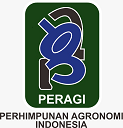Evaluasi Toleransi Salinitas Beberapa Genotipe Padi (Oryza sativa L) Menggunakan Nilai Indeks
Abstract
Padi merupakan tanaman yang tergolong rentan terhadap lingkungan salinitas (garam tinggi) sehingga dapat menurunkan produktivitas. Faktor genotipe dan lingkungan cekaman salinitas (konsentrasi dan durasi) masing-masing berpengaruh nyata terhadap semua peubah morfologi dan komponen hasil. Pendugaan nilai indeks terhadap toleransi tanaman adalah proses untuk mengukur atau memperkirakan indeks toleransi suatu tanaman terhadap kondisi lingkungan yang berpotensi merusak. Penelitian ini bertujuan untuk mengevaluasi keefektifan beberapa perhitungan nilai indeks toleransi cekaman untuk memilih genotipe padi yang toleran cekaman salinitas. Percobaan dilakukan di rumah kaca Balai Besar Pengujian Standar Instrumen Tanaman Padi, Jawa Barat. Penelitian ini dibagi menjadi dua unit percobaan. Pertama dengan kondisi optimum. Kedua pada kondisi salin dengan EC terkontrol 5 dS/m sepanjang fase hidup. Hasil penelitian menunjukan terdapat satu genotipe yang toleran terhadap cekaman salinitas dan memiliki hasil lebih besar dibandingkan varietas pembanding yaitu G9 (IR 129336:11-19-Ski-0-KN-20.) dengan nilai Yp=25.39gram dan Ys=5.74gram. Analisis clustergram berdasarkan nilai indeks SSI membagi genotipe menjadi 4 kelompok yaitu sangat rentan, rentan(R), toleran vegetatif rentan generatif(TVRG), dan rentan vegetatif toleran generatif (RTVG).
Keywords
Full Text:
PDFReferences
Andayani, N. N., Riadi, M., Roy, E., & Azrai, M. (2019). Respon genotipe jagung hibrida silang tiga jalur terhadap cekaman intensitas cahaya rendah. Buletin Penelitian Tanaman Serealia, 3(1), 1–8.
Bennani, S., Nsarellah, N., Jlibene, M., Tadesse, W., Birouk, A., & Ouabbou, H. (2017). Efficiency of drought tolerance indices under different stress severities for bread wheat selection. Australian Journal of Crop Science, 11(4), 395–405. https://doi.org/10.21475/ajcs.17.11.04.pne272
Bouslama, M., & Schapaugh, W. T. (1984). Stress tolerance in soybeans. I. Evaluation of Three Screening Techniques for Heat and Drought Tolerance 1. Crop Science, 24(5), 933–937. https://doi.org/10.2135/cropsci1984.0011183X002400050026x
Dadbakhsh, A., Yazdansepas, A., & Ahmadizadeh, M. (2011). Corresponding Author Study Drought Stress on Yield of Wheat (Triticum aestivum L.) Genotypes by Drought Tolerance Indices. Advances in Environmental Biology, 5(7), 1804–1810.
De Leon, T., Linscombe, S., Gregorio, G., & Subudhi, P. (2015). Genetic variation in Southern USA rice genotypes for seedling salinity tolerance. Frontiers in Plant Science, 6, 1–13. https://doi.org/10.3389/fpls.2015.00374
Efendi, R., & Azrai, M. (2015). Kriteria indeks toleran jagung terhadap cekaman kekeringan dan nitrogen rendah. Prosiding Seminar Nasional Serealia.
Farshadfar E, & Javadinia J. (2011). Evaluation of chickpea (Cicer arietinum L.) genotypes for drought tolerance. Seed Plant Improv Journal, 24(4), 517–537.
Fernandez, G. C. J. (1992). Effective selection criteria for assesing plant stress tolerance. In Adaptation of Food Crops to Temperature and Water Stress. International symposium.
Fischerab, R. A., & Maurerac, R. (1978). Drought resistance in spring Wheat Cultivars. I grain yield responses. Aust. J. Agric. Res, 29, 897–912.
Gregorio, G. B., Senadhira, D., & Mendoza, R. D. (1997). Screening rice for salinity tolerance.
Hairmansis, A., & Nafisah. (2020). Development of improved rice varieties for saline affected areas.
Ismail, A. M., Heuer, S., Thomson, M. J., & Wissuwa, M. (2007). Genetic and genomic approaches to develop rice germplasm for problem soils. Plant Molecular Biology, 65(4), 547–570. https://doi.org/10.1007/s11103-007-9215-2
Jafari, A., Paknejad, F., & Al-Ahmadi, M. J. (2009). Evaluation of selection indices for drought tolerance of corn Zea mays L. hybrids. International Journal of Plant Production, 3(4), 1735–8043. www.ijpp.info
Jamshidi, A., & Javanmard, H. R. (2018). Evaluation of barley (Hordeum vulgare L.) genotypes for salinity tolerance under field conditions using the stress indices. Ain Shams Engineering Journal, 9(4), 2093–2099. https://doi.org/https://doi.org/10.1016/j.asej.2017.02.006
Liu, C., Mao, B., Yuan, D., Chu, C., & Duan, M. (2022). Salt tolerance in rice: Physiological responses and molecular mechanisms. In Crop Journal (Vol. 10, Issue 1, pp. 13–25). Institute of Crop Sciences. https://doi.org/10.1016/j.cj.2021.02.010
Nafisah, Hairmansis, A., & Sitaresmi, T. (2017). Grain yield of rice elite lines under saline prone condition in Cilamaya Wetan, Karawang Subdistrict West Java. Journal of Suboptimal Lands, 6(1), 21–32. www.jlsuboptimal.unsri.ac.id
Naseri, M. A., Bayat, H., Aminifard, M. H., & Moradinezhad, F. (2019). Effect of drought and salinity stress on growth, flowering and biochemical characteristics of Narsicuss tazetta L. Journal Of Horticultural Science, 33(3), 451–466. https://doi.org/10.22067/jhorts4.v0i0.76772
Rosielle, A. A., & Hamblin, J. (1981). Theoretical aspects of selection for yield in stress and non-stress environments. Crop Science, 21, 943–946.
Rumanti, I. A., Hairmansis, A., Nugraha, Y., Nafisah, Susanto, U., Wardana, P., Subandiono, R. E., Zaini, Z., Sembiring, H., Khan, N. I., Singh, R. K., Johnson, D. E., Stuart, A. M., & Kato, Y. (2018). Development of tolerant rice varieties for stress-prone ecosystems in the coastal deltas of Indonesia. Field Crops Research, 223, 75–82. https://doi.org/10.1016/j.fcr.2018.04.006
Saini, S., Kaur, N., Marothia, D., Singh, B., Singh, V., Gantet, P., & Pati, P. K. (2021). Morphological analysis, protein profiling and expression analysis of auxin homeostasis genes of roots of two contrasting cultivars of rice provide inputs on mechanisms involved in rice adaptation towards salinity stress. Plants, 10(8), 1–20. https://doi.org/10.3390/plants10081544
Santhiawan, P., & Suwardike, P. (2019). Adaptasi padi sawah (Oryza sativa L.) terhadap peningkatan kelebihan air sebagai dampak pemanasan global. Agrobali Agricultural Journal, 2(2), 130–144.
Sihaloho, A. N., & Purba, J. (2021). Evaluasi karakter vegetatif F3 tanaman kedelai (Glycine max L.) hasil seleksi pedigree pada tanah masam dataran tinggi. Agrobali Agricultural Journal, 4(1), 74–93. https://doi.org/10.37637/ab.v4i1.686
Singh, S. K., Sengar, R. S., Kulshreshtha, N., Datta, D., Tomar, R. S. S., Rao, V. P., Garg, D., & Ojha, A. (2015). Assessment of multiple tolerance indices for salinity stress in bread wheat (Triticum aestivum L.). The Journal of Agricultural Science, 7, 49. https://api.semanticscholar.org/CorpusID:55757299
Suhartini, T., & Harjosudarmo, T. Z. P. (2017). Tolerance of local rice germplasm to salinity. Bul. Plasma Nutfah, 23(1), 51–58.
Tao, R., Ding, J., Li, C., Zhu, X., Guo, W., & Zhu, M. (2021). Evaluating and screening of agro-physiological indices for salinity stress tolerance in wheat at the seedling stage. Frontiers in Plant Science, 12. https://doi.org/10.3389/fpls.2021.646175
Widyastuti, Y., Purwoko, S. B., & Yunus, M. (2016). Identifikasi toleransi kekeringan tetua padi hibrida pada fase perkecambahan menggunakan Polietilen Glikol (PEG) 6000. J. Agron. Indonesia, 44(3), 235–241.
Wu, H., Guo, J., Wang, C., Li, K., Zhang, X., Yang, Z., Li, M., & Wang, B. (2019). An effective screening method and a reliable screening trait for salt tolerance of brassica napus at the germination stage. Frontiers in Plant Science, 10. https://doi.org/10.3389/fpls.2019.00530
Zhao, S., Zhang, Q., Liu, M., Zhou, H., Ma, C., & Wang, P. (2021). Regulation of plant responses to salt stress. International Journal of Molecular Sciences, 22(9). https://doi.org/10.3390/ijms22094609
Refbacks
- There are currently no refbacks.



























